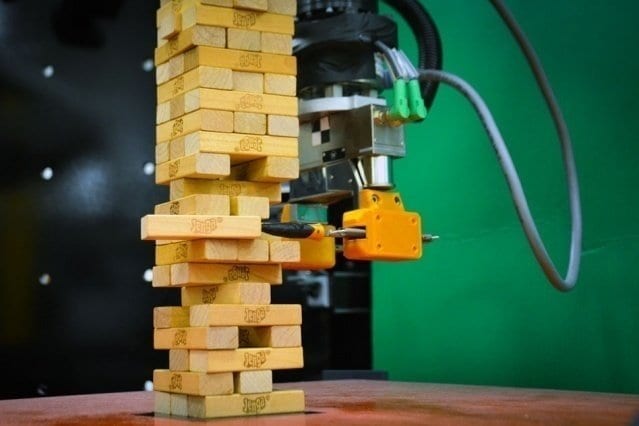
A study by engineers at Oregon State University suggests that they have achieved the most realistic robotic implementation of human walking dynamics that has ever been done, which may ultimately allow human-like versatility and performance.
The system is based on a concept called “spring-mass” walking that was theorized less than a decade ago, and combines passive dynamics of a mechanical system with computer control. It provides the ability to blindly react to rough terrain, maintain balance, retain an efficiency of motion and essentially walk like humans do.
As such, this approach to robots that can walk and run like humans opens the door to entire new industries, jobs and mechanized systems that do not today exist.
The findings on spring-mass walking have been reported for the first time in IEEE Transactions on Robotics, by engineers from OSU and Germany. The work has been supported by the National Science Foundation, the Defense Advanced Research Projects Agency and the Human Frontier Science Program.
The technologies developed at OSU have evolved from intense studies of both human and animal walking and running, to learn how animals achieve a fluidity of motion with a high degree of energy efficiency. Animals combine a sensory input from nerves, vision, muscles and tendons to create locomotion that researchers have now translated into a working robotic system.
The system is also efficient. Studies done with their ATRIAS robot model, which incorporates the spring-mass theory, showed that it’s three times more energy-efficient than any other human-sized bipedal robots.
“I’m confident that this is the future of legged robotic locomotion,” said Jonathan Hurst, an OSU professor of mechanical engineering and director of the Dynamic Robotics Laboratory in the OSU College of Engineering.
“We’ve basically demonstrated the fundamental science of how humans walk,” he said.
“Other robotic approaches may have legs and motion, but don’t really capture the underlying physics,” he said. “We’re convinced this is the approach on which the most successful legged robots will work. It retains the substance and science of legged animal locomotion, and animals demonstrate performance that far exceeds any other approach we’ve seen. This is the way to go.”
The current technology, Hurst said, is still a crude illustration of what the future may hold. When further refined and perfected, walking and running robots may work in the armed forces. As fire fighters they may charge upstairs in burning buildings to save lives. They could play new roles in factories or do ordinary household chores.
Aspects of the locomotion technology may also assist people with disabilities, the researchers said.
“Robots are already used for gait training, and we see the first commercial exoskeletons on the market,” said Daniel Renjewski, the lead author on the study with the Technische Universitat Munchen. “However, only now do we have an idea how human-like walking works in a robot. This enables us to build an entirely new class of wearable robots and prostheses that could allow the user to regain a natural walking gait.”
There are few limits to this technology, the researchers said.
Read more: Spring-mass” technology heralds the future of walking robots
The Latest on: Walking Robots
[google_news title=”” keyword=”Walking Robots” num_posts=”10″ blurb_length=”0″ show_thumb=”left”]
via Google News
The Latest on: Walking Robots
- Chinese company unveils humanoid running robot with large-scale commercial potentialon April 27, 2024 at 7:00 am
Tiangong, a humanoid robot described as the world's first full-sized humanoid robot capable of running solely on electric drive, was unveiled in the Beijing Economic-Technological Development Area on ...
- Apple Vision Pro Sales Slump, Robot Weapons Get Scarier, TikTok Ban Is Here and Moreon April 27, 2024 at 4:30 am
Apple got a dose of reality as people are caring less about its Vision Pro. A robot tank with green eyes and a robo dog with a flamethrower show that the future of warfare is here. And to round things ...
- This nation of dog lovers can become a nation of robot loverson April 26, 2024 at 11:00 pm
One’s hurtling through interstellar space, destination unknown, the other ploughing a lonely path across the sitting room. Both have their journeys programmed, one sucks in data the other dust. While ...
- Best Evil Robot You Can Buy: Robosen's Megatron Auto-Transforms via Voice Commandson April 25, 2024 at 9:17 am
The iconic Transformers villain comes to life in a self-converting robot that turns into a tank. It's a killer toy.
- The robots are coming ... for your weddingon April 25, 2024 at 6:33 am
NEW YORK — After the vows, the champagne toasts, the filet mignon and the first dance between the bride and groom — after all the normal wedding stuff — came the cue. The cue for the abnormal wedding ...
- You Should Share a Robot Lawn Mower With Your Neighborson April 25, 2024 at 6:02 am
You can make a robot lawn mower more affordable by sharing it with your neighbors. Here's how to set your bot up to do so.
- Tesla’s Optimus robot could be on sale next year, says Elon Muskon April 24, 2024 at 7:19 am
While disclosing the anticipated release date, Musk claimed that Optimus robots could become Tesla’s most valuable asset.
- Korean robot startup aims to transform human walkingon April 23, 2024 at 11:31 pm
South Korean robotics startup WIRobotics aims to transform the walking experience via its award-winning wearable robot WIM, made lighter and more convenient for everyday use, the company's chief said ...
- Tesla could start selling Optimus robots by the end of next year, Musk sayson April 23, 2024 at 5:20 pm
Tesla's humanoid robot is still in the lab, but it may be ready to sell as soon as the end of next year, chief executive Elon Musk said on Tuesday.
- Thermonator, the Flame-Throwing Robot Dog, Can Now Be Yours for $9,420on April 23, 2024 at 2:44 pm
The Thermonator, the product of Ohio flame thrower manufacturer Throwflame, is a 26-pound robotic quadruped that comes equipped with one of the company’s characteristic ARC flamethrowers mounted on ...
via Bing News










